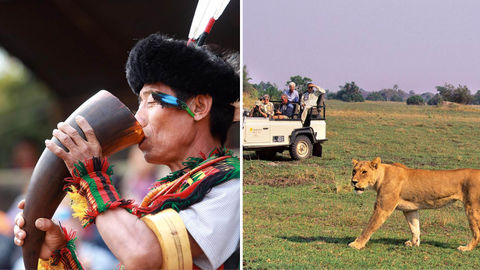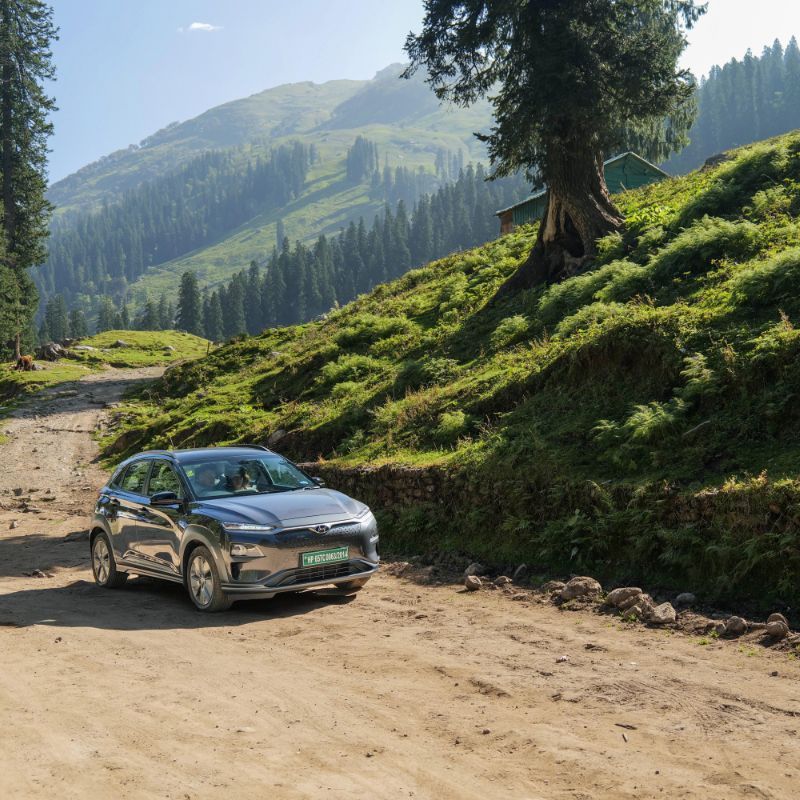
The onus of healing the planet is on each one of us. But how exactly do you reduce your carbon footprint while travelling? We ask experts for tips on treading various terrains—from lush jungles to heritage sites, hills and cities.
Responsible Tourism has been the buzzword for a few years now, and evident geo-climatic changes have shown us repeatedly why it’s more than just a trend. The COVID-19 pandemic has not only put our priorities in perspective but also shown us that the Earth can actually heal—if we start treading lightly. It’s important that when we start exploring again, we are aware of the impact our travel choices have on the planet. But too many people use the terms ‘responsible travel’ and ‘ecotourism’ loosely. In order to set the
record straight and filter facts from hashtags, we spoke to field experts for tips on acting responsibly on different terrains.

MOUNTAIN ESCAPES
Mandip Singh Soin, a mountaineer, founder of Ibex Expeditions (ibexexpeditions.com), and founder of Ecotourism Society of India (now RTSOI, rtsoi.org), states that the golden rule in the Himalayas is, “Pack in, pack out.” Even if you throw an empty plastic bottle in a designated bin, you may think that you are not littering, but everything takes longer to degrade at higher altitudes. For example, a banana peel that degrades in about three to four weeks in the plains takes almost six months at an altitude of 3,650 metres above sea level. Hence, it’s worth spending extra on a porter to carry all the non-biodegradable material back with you.

Soin also has valuable tips for camping responsibly. When you need to dig a pit to go to the toilet, ensure that you cut out the turf—the size of a plate—keep it aside, and then dig at least two-three feet. Before moving on from the campsite, fill the pit with mud and then cover it back again with the turf that you had kept aside to allow the grass to regenerate. Nothing is more horrifying than reaching a pristine meadow after trekking for hours, only to be greeted by waste. This may sound heartbreaking, but a campfire should be avoided. Apart from creating pollution and the risk of starting forest fires, foraging wood for a campfire eats into the fuel of the local community. Instead, he suggests using solar lanterns and sitting together in a large tent, as you play games or sing songs. Contrary to popular methods, it is important to camp at least 30 metres away from free-flowing water.
Instead of washing your utensils or bathing in the water body, fill a bucket with fresh water, go back near your campsite, and do the cleaning jobs. This ensures that you don’t pollute the water body. “We have to move away from the capitalist thinking of ‘customer is king’ to ‘environment is king’,” Soin concludes.
JUNGLE TRIPS
By planning your safaris well, you can put less pressure on the fragile ecosystem of forests. “You can reduce your footprint by abstaining from single-use plastic and using biodegradable soaps and shampoos,” says wildlife conservationist Latika Nath. She goes on to add that there are long-term effects of chemical shampoos and soaps on the environment. It is also important to use resources optimally. If a safari vehicle can seat six people, try and utilise all the seats rather than taking one jeep into the jungle for just two people.
Nath also has some packing tips for your safari holiday. Leave all plastic at home; carry cloth bags, silicon bags, and paper bags instead. Instead of tissues and wet wipes, carry quick-drying towels that can be used and reused. Decant chips and snacks into air-tight jars that you can bring back. This also means packing food like nuts and energy bars that are easy to carry and handle while you’re travelling.

If travelling with children, Nath has a few additional suggestions. Use a jungle holiday to
introduce your tots to non-fizzy drinks. Go the old-fashioned way and keep Tang or cordial, which you can mix and have as a refreshing drink rather than cans and plastic soda bottles. Avoid activities that involve one-time-use items. If the kids like colouring, carry a drawing pad rather than loose sheets. The pens and crayons you carry can be gifted to children
in local villages.
CITY TOURS
‘Community first’ is the mantra of Harshwardhan Tanwar, co-founder of No Footprints (nfpexplore.com), a company curating niche travel experiences in Mumbai and New Delhi. Travel is all about people, and when you interact with local communities, you must understand that they have been living in a certain way for years. The Queer Day Out is an award-winning tour by No Footprints that showcases the queer side of Mumbai through interaction with queer artists, undertaking a workshop by a drag queen, or visiting a temple of a goddess worshipped by local transgender communities.

Sustainable consumption is another important aspect of responsible travel. Citing some of their popular food tours in Mumbai, Tanwar suggests resisting from ordering pomfret through the year and opting for seasonal fish like kingfish or Bombay duck instead.
“Due to the high demand for pomfret, restaurants try to provide it throughout the year. This puts pressure on fishermen to get pomfret even if it impacts the fish’s breeding cycle and ecology,” he explains. Customers’ appreciation for seasonally available produce can encourage local businesses to value the same.
According to Tanwar, slow travel also helps a lot. Looking at alternative modes of transport and spending more time at a destination gives travellers the opportunity to engage with the community and taste local delicacies.
OFFBEAT HOLIDAYS
Piran Elavia, Founder of Kipepeo (kipepeo.in), a Mumbai-based firm specialising in tours to Northeast India, says that understanding the culture of the destination is a prerequisite for being a responsible traveller. “The culture of the Northeast is very different from that of mainland India,” he shares. The 178 tribes here may come across as too liberal in terms of their clothing and lifestyle. Respecting their lifestyle choices is imperative for behaving responsibly. They also partake in a lot of meat, especially pork, and alcohol. Elavia says he has seen many instances of travellers getting offended by the food and drink that was offered to them.

Another way to be more sensitive to the local culture relates to photography. “In the Northeast, the older members of various tribes wear attractive facial tattoos and ornaments. While they make great subjects for pictures, tourists should ask for permission before clicking their photographs,” he says. Elavia also wants independent travellers to experience homestays as they provide a more immersive experience.
A prime example of the Northeast’s green credentials is Sikkim, which became India’s first fully organic state in 2016. Elavia explains that waste management is taken very seriously in the state. Even in the smallest of shops, you’ll find colour-coded dustbins for waste segregation. Travellers, too, must respect and observe such salient practices.
HERITAGE DESTINATIONS
Behaving responsibly at a heritage destination is not just about preserving old buildings and monuments, but also protecting cultural heritage. Talking about big fat Indian weddings that are hosted at heritage destinations, Rakesh Mathur, honorary president of The Responsible Tourism Society of India (RTSOI), says hiring local musicians and dancers rather than electronic music and DJs can reduce your footprint. A majority of heritage destinations are located in rural areas. Besides the usual guidelines, travellers must recognise the lack of infrastructure here, including drainage facilities, piped water, and electricity, and act accordingly. “Rajasthan leads the country in heritage tourism, but you have to see the amount of plastic waste that is generated there,” laments Mathur. Draw the line between hygienic comfort and indulgent luxury, he says. The rule of thumb is to ‘carry your garbage back with you’.

BOOKING TIP
Invest some time in researching businesses that are doing genuinely sustainable work. “A good way is to see how many boxes they can tick off,” suggests Latika Nath, wildlife photographer and conservationist. For instance, a resort may be housed in a concrete building but maybe tapping solar energy, using water and electricity efficiently, disposing of grey water sustainably, harvesting rainwater, recycling groundwater, and supporting the local community. It may turn out to be more responsible than another one constructed in the local architectural style.
Related: Ishita Khanna Of Spiti Ecosphere Decodes The Pillars Of Conscious Travelling










